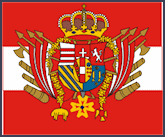Grand Duchy Of Tuscany
 Tuscany is the Etruria of the ancients. It was conquered by the Romans 280 BC. After the fall of that empire it successively belonged to the Goths and Lombards, by the last of which it was erected into a duchy. Charlemagne conquered Tuscany, but under his feeble successors its princes made the country independent. In the 12th and 13th centuries Tuscany was partitioned among the famous republics of Florence, Pisa, and Siena; but these were re-united in 1531 into one duchy, under Alexander Medici, in whose family it remained until its extinction in 1737, when it fell into the hands of the house of Austria. In 1801, Napoleon erected it into the Kingdom of Etruria, in favor of the Prince of Parma: but in 1808 it was incorporated iuto the French Empire, and subdivided into the departments of Arno, Mediterranean, and Ombrone. Since 1814 it has reverted to Austria, and was governed by one of the Archdukes.
Tuscany is the Etruria of the ancients. It was conquered by the Romans 280 BC. After the fall of that empire it successively belonged to the Goths and Lombards, by the last of which it was erected into a duchy. Charlemagne conquered Tuscany, but under his feeble successors its princes made the country independent. In the 12th and 13th centuries Tuscany was partitioned among the famous republics of Florence, Pisa, and Siena; but these were re-united in 1531 into one duchy, under Alexander Medici, in whose family it remained until its extinction in 1737, when it fell into the hands of the house of Austria. In 1801, Napoleon erected it into the Kingdom of Etruria, in favor of the Prince of Parma: but in 1808 it was incorporated iuto the French Empire, and subdivided into the departments of Arno, Mediterranean, and Ombrone. Since 1814 it has reverted to Austria, and was governed by one of the Archdukes.
In the mid-19th Century this large state was situated in Middle Italy, extending from the coast almost entirely to the west of the crest of the Appenines, and is bounded on the north by Parma and Modena, and on the east and south by the Papal States. The Grand Duke was an Austrian ; but the policy of the government has long bean distinguished for its liberality and efficiency.
Elba, and several other islands in the Mediterranean belonged to Tuscany. In the mid-19th Century the territory contained 8,381 square miles, or 5,365,120 acres, which were thus occupied :-in the cultivation of the vine, 570,000 ; vine and olive, 390,000; arable, 840,000 ; woods, 1,400,000 ; chestnuts, 305,000 ; natural and artificial meadows, 70,000; pastures, 1,600,000; various smaller products, 70,000; building, 26,000-the small remainder being unemployed and not subject to taxation. The population amounted to about 1,600,000, or 190 to the square mile. The army consisted of from 7,000 to 8,000 men, who were levied by a sort of conscription, and served for six years. Education was much neglected, and the only institutions of note were the universities of Pisa and Siena. The annual revenue amounted to some 25,000,000 lire, (about $4,000,000,) produced from the land-tax, customs, salt and tobacco monopolies, lotteries, &,c. The public debt is small, and its security unquestioned. The improvements of the Maremma occasioned much of the extraordinary expenditures. Tuscany was divided into five " compartimenti," and these again into "territori-comunitativi."
Florence, (Firenze la Bella,) the capital, is situated on the Arno, in a delightful valley. It is considered one of the finest cities of the world, and is noted for its antique appearance, and the solidity and beauty of its palaces, churches, and other public edifices. Population, 100,000. In the neighborhood of the city are many villas and country houses, noled for their historical associations. Vallombrosa, Prato, Pistoja, Pescia, Volterra, and Signa, are places of some consideration, within a short distance of Florence. Volterra is noted for its salt works, and Signa may be considered as the centre of the straw-hat manufactures, a handicraft which forms not only a chief employment to the Tuscans, but which also furnishes an article of commerce to every other country.
Pisa, an ancient but now decayed city, the capital of a sovereign republic in the middle ages, and the great rival of Genoa, is situated on the right bank of the Arno, near its mouth. With the exception of its literary institutions and numerous antiquities, Pisa has no modern attractions. Population, 20,000. Some valuable marbles are quarried in the neighborhood.
Leghorn, (Livorno,) a fine modern city, on the shores of the Mediterranean, is one of the principal commercial towns of Europe, an advantage that it owes to its being a free port, where the productions of all countries can be landed and re-shipped without restriction. One of its quarters is called New Venice, from its being intersected by a number of canals, by means of which goods are brought to the doors of the warehouses. The harbor is entirely artificial, and is formed and defended by a great mole or bulwark, and by strong military works; and outside is the road, formed by sandbanks surrounding the island of Meloria, on which the light-house is built . The city is two miles in circumference, and contains about 80,000 inhabitants, of whom one-fourth are Jews. The great square is spacious, and the Duomo or Cathedral, is a noble building. Leghorn in the 15th century was only an inconsiderable port, and it was not until the middle of the 17th century that its liberality to the Jews, and other strangers, laid the foundation of its modern prosperity, and accomplished the transfer of Tuscan commerce to its port. Its ship-building is extensive, and vessels of war of 60 guns have been built in its slips.
|
NEWSLETTER
|
| Join the GlobalSecurity.org mailing list |
|
|
|

